People looking for a way to safely invest their extra cash should consider Lending Club. Since its launch in mid-2007, the peer to peer lender has paid over $540 million to tens of thousands of investors, with most people earning a 5-9% return per year. The company continues to experience over 100% annual growth, and is regularly mentioned in major news outlets as one of the most promising companies in America (Forbes).
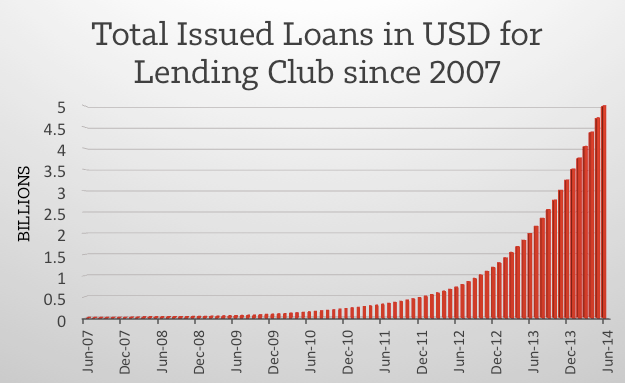
Today we will review the investor side of Lending Club – how it works, what to expect, and how to get started. Let’s begin.
What is Lending Club? An Overview of Peer to Peer Lending
What Lending Club does is quite simple. They use the internet to connect people who need a loan with people who have extra money to lend. The term for this type of lending is called peer to peer lending, and it is brand new to the way America thinks about its finances. In short, it is loans without the banks. Instead of a borrower parking their car at Chase Bank and walking through the door to apply for a loan, they turn to a website like Lending Club. Since Lending Club cuts out this bank and operates online, it can pass the savings over to the customer, giving these borrowers a lower interest rate than anywhere else.
Peer to peer lending is the crowdfunding of loans over the internet.
As an investor, you earn a return by lending your extra cash to these creditworthy borrowers. You do this by investing in notes, or $25 portions each loan. This way you can spread (diversify) your investment across hundreds of loans, while the borrowers can have loans (up to $40,000) funded by hundreds of different investors. In short, peer to peer lending is the crowdfunding of loans over the internet.
Peer to peer lending in 3 steps:
- Open an account and invest in notes (portions of loans)
- Borrowers pay their loans back month by month (with interest)
- Take these payments and invest in more notes, watching your account grow
Note: Some people cannot invest money at Lending Club
Not every investor is currently eligible to lend money through Lending Club. There are a few requirements that you have to meet when you open an account. For instance, you must live in one of the eligible states:
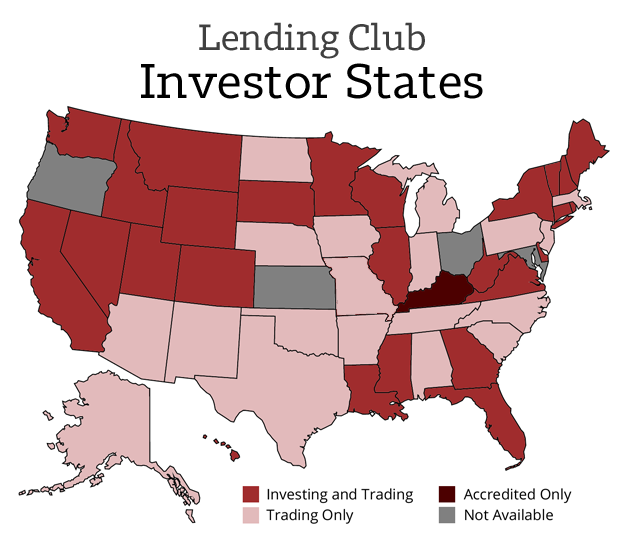
The reason for this scattered map is that Lending Club investments have legally been classified by the SEC as securities. As a result, Lending Club has had to approach the regulators of every state one by one for approval, and some are not yet on board.
Live in a Lending Club investor state?
Open an account (free)
3 Great Reasons to Invest at Lending Club
If tens of thousands of individual investors are moving their excess cash to Lending Club, the company must be doing something right. LendingMemo polled our readership to ask why they invest. Here are three of the most common answers:
#1. Returns of 5-10% per year
The main reason people come to Lending Club is the return it gives them on their invested cash. The loans they fund typically have a 14% interest rate. Minus a 4-5% default rate plus 1% given to Lending Club in fees, that leaves most investors with an 8% return by the time their account matures (14% minus 6% = 8%).
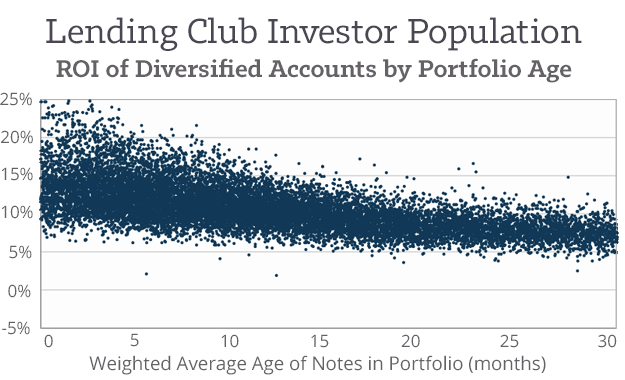
Many Americans typically keep their extra cash in a savings account. What is the average rate on a savings account in the United States? Around 0.5% (source), a fraction of the return that most peer to peer investors are earning.
#2. A consistent investment
Even in a recession, peer to peer loans are a good investment. During 2008, the national economy experienced the worst financial fall since the Great Depression. During that same year, Lending Club still managed to return investors 3% overall.
How is this possible? In short, peer to peer loans are less tied to the stock market than most traditional investments. They are only issued to good-credit borrowers who are remarkably consistent in their repayments, even in tough times.
#3. Peer to peer lending just makes sense
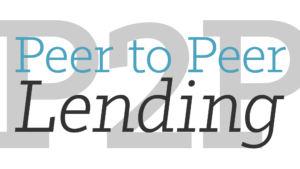 Investing in the stock market can be confusing, and it is difficult to see your money helping anybody. But investors at Lending Club often feel good about their investment because it is being used to help people get out of credit card debt. Over 80% of the borrowers at Lending Club are people consolidating their debts at a lower rate.
Investing in the stock market can be confusing, and it is difficult to see your money helping anybody. But investors at Lending Club often feel good about their investment because it is being used to help people get out of credit card debt. Over 80% of the borrowers at Lending Club are people consolidating their debts at a lower rate.
In short, peer to peer lending is really simple to understand. People need help getting out of debt, so you lend them the money to make that happen, earning interest in the process.
Investing at Lending Club Does Involve Risk
While there are great reasons to invest at Lending Club, there are risks as well:
Risk #1. Defaulting loans (most common)
The biggest risk that you take on as an investor at Lending Club is a loss of your investment to defaults, a ‘default’ being a loan that a borrower has failed to pay back. New investors be aware: these are unsecured debts. They are not secured by a house or any sort of collateral. If your borrowers want to declare bankruptcy, they can. You would then lose everything you had invested with them.
Spread your investment across at least 200 loans.
To combat this, we diversify our investment. The most important thing in peer to peer lending is to spread your investment across at least 200 loans. Since the smallest portion of a loan you can invest in is $25, this means most investors need to start with $5,000. Investing in 200 loans will likely keep your default rate at a reasonable and consistent level. LendingMemo did a study last year, and found that just 4 out of 3800 diversified investors had lost money.
There are a few exceptional circumstances that could increase this default rate. For instance, if the national economy fell apart and the unemployment rate shot up, Lending Club’s default rate would likely go up as well.
Risk #2. Rising interest rates (less likely)
A rise in the national interest rate could affect Lending Club’s business model. After all, if investors can get a risk-free 6% return in a savings account, why would they earn 6% with borrowers who might default on their loans? A high-interest rate environment would definitely impact investors. That said, I think peer to peer lending would simply adjust to this reality. Lending Club might struggle to get investors for lower-risk loans that earn 5-6%, but there would still be demand for medium-risk loans that return 7-10%.
Risk #3. Underwriting degradation (unlikely)
We are dependent upon peer to peer lending platforms like Lending Club to underwrite all of our loans, making sure that our money is only lent out to creditworthy individuals. If they suddenly lowered their minimum credit score for a loan to 550 (currently it’s 660) because they needed a larger supply of borrowers, investors would certainly have a higher rate of default and a potentially worse investment.
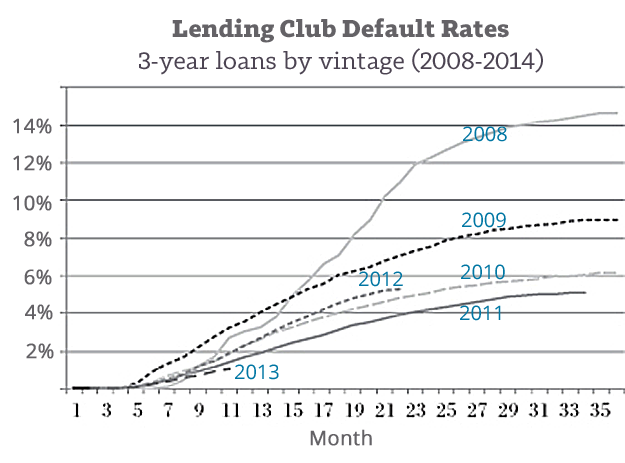
This is something to keep in mind, but it isn’t huge. Since all Lending Club loan data is available for people to download, many statisticians watch it to ensure borrower standards are kept high. On the contrary, Lending Club’s overall default rate has actually gone down each year (see chart above), so the underwriting is actually improving.
Risk #4. Lending Club may go bankrupt (unlikely)
In case of a bankruptcy, a backup servicer is in place to funnel borrower payments to investors. That said, there has never been a peer to peer lender bankruptcy before, so we do not really know what would happen. In a worse case scenario, lenders might lose large portions of their investment to satisfy the company’s creditors.
However, Lending Club has experienced such phenomenal success that this is less of a concern today than it has ever been. When the company was brand new, this was an often cited risk. Today, few are worried about it.
Risk #5. Unforeseen risks
Unlike stocks or bonds, where we have a hundred years of history to look at, peer to peer lending is less than a decade old, so there are a variety of unknowns that could impact us. Lending Club is still a young company that evolves and changes each year. This is a good reason to subscribe to the monthly LendingMemo newsletter so as to keep tabs on the industry.
The Most Important Thing: Diversification
 As I mentioned in Risk #1, the most common reason that new investors experience poor or negative returns at Lending Club is because they do not diversify in enough loans. If you want to begin investing, you should seriously consider spreading your cash across 200+ equally-weighted notes. Since the minimum loan portion at Lending Club is $25, this means every investor should be starting with $5,000 (200 x $25 = $5,000). You can invest using larger portions — just make sure you have 200 notes. People with $10,000 to invest could use $50 notes; people with $50,000 could use $250 notes, etc.
As I mentioned in Risk #1, the most common reason that new investors experience poor or negative returns at Lending Club is because they do not diversify in enough loans. If you want to begin investing, you should seriously consider spreading your cash across 200+ equally-weighted notes. Since the minimum loan portion at Lending Club is $25, this means every investor should be starting with $5,000 (200 x $25 = $5,000). You can invest using larger portions — just make sure you have 200 notes. People with $10,000 to invest could use $50 notes; people with $50,000 could use $250 notes, etc.
You may be able to invest with just $2,000 (80 notes), but you must only invest in the safest A-grade loans. Read: How to Try Peer to Peer Lending with $2,000
Investing on Lending Club: A Walkthrough
Now that we have explored the benefits and risks of Lending Club, all that’s left is to take a look at their website. Let’s do that now:
Screen #1. The main account page
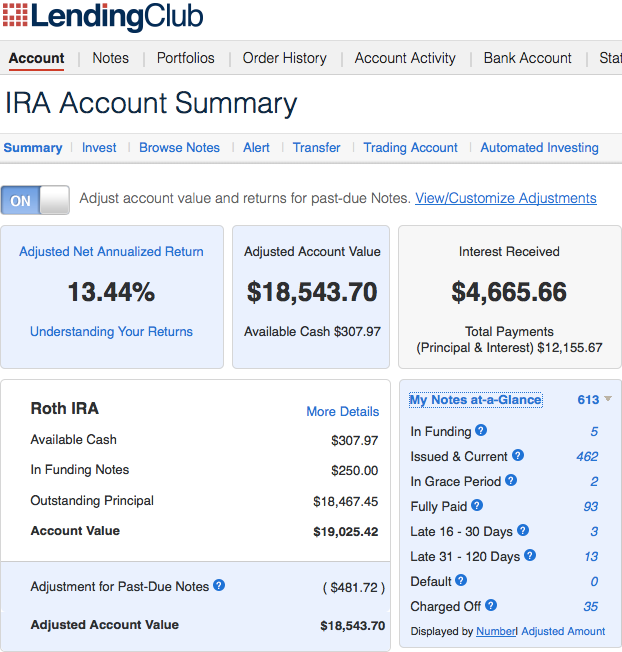
This is my personal IRA at Lending Club, and is an example of the main account page for every investor. The most important information is layered here, with a focus on three big numbers:
- The account’s return (see above: 13.44%)
- Current value (above: $18,543)
- Earned interest (above: $4,665)
These three numbers are followed by other important figures, such as the amount of available cash in my account as well as the status of all my invested notes. In this example, you can see I have 462 notes that are healthy, 35 notes that have defaulted (charged-off), and a variety of loans in various stages of lateness.
Note: I am not actually earning 13%, as the graphic seems to indicate. I have traded on the secondary market, which makes my account page inaccurate. My actual return, calculated via XIRR( ) in Excel, is around 11%.
Screen #2. Lending Club’s list of available loans
Clicking on the Browse Notes link in the previous picture would bring us to this screen:
On the Browse Notes screen you can see all the loans currently available for investment at Lending Club. Each one of these loans represents a prime borrower who has passed Lending Club’s credit standards.
In this example, the number in the upper right (see the arrow) shows that 324 loans are currently available for investment. We can sort and filter this list of available notes by different criteria to find the investment that is right for each of us.
Loan Grades (A through G): The factor most investors pay attention to is the Rate column, indicated in the picture by the colored boxes. Lending Club has seven loan grades (blue As are the safest – orange Gs are the riskiest), and each grade measures that loans risk. While all the loans at Lending Club are for creditworthy borrowers, every loan can still default, and some loans default more often than others. The amount of risk we invest in has a strong effect on our accounts overall return. For example, I personally invest in riskier loans (grades D-G) and that approach has earned me over 10% per year. Others stick with safer A-grades and earn a respectable 5% return.
Screen #3. The automated investing tool
Choosing individual loans one by one can become quite time consuming. Most investors, including myself, have instead chosen to automate our investment at Lending Club using their Automated Investing tool.
This tool makes investing at Lending Club a snap. After selecting your ideal mix of loan grades (risk) and note size ($25 for most), you can set the tool to automatically invest in loans for you. Personally speaking, each day I receive an email from Lending Club’s automated tool telling me they have invested in notes that meet my criteria. Sometimes I go to the Lending Club website and check my returns to see how they are doing, but there is usually no need to do this. Automated investing at Lending Club has made my investment a nearly hands-off experience.
Screen #4. The notes page
Anytime you want to see your individual loan investments, you can navigate to the Notes tab. Here you can get a bird’s eye view of your account, place loans into portfolios, and click on each loan to see that loan’s details. If you see a large portion of loans defaulting, you might examine them one by one to see if they have something in common – informing your investment strategy in the future.
Choosing Your Risk Tolerance (and Retirement Account)
As mentioned earlier in this post, there are different degrees of risk you can take on as a Lending Club investor. You could go the safer route and invest in just A and B-grade loans. Or you could copy what most investors do: spread your investment across all the different loan grades for a balance of risk and return.
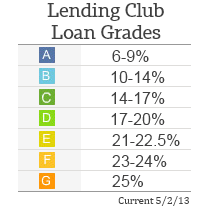 The degree of risk you take on will impact your overall return. As see in the chart on the right, borrowers pay just 6% for an A-grade loan. After defaults and fees, you may earn around 5% on these loans. However, if you invest in riskier loans like D-grades, borrowers are paying 17-20% on these loans. After defaults and fees, you may earn closer to 8-10%. I am younger and without children, so I prefer to take on more risk. But, for example, if you are close to retirement, you may want to invest in the safer lower-risk grades. These loans have lower volatility; there is some evidence that shows safer A-grade loans being less impacted by negative factors like a rise in national unemployment.
The degree of risk you take on will impact your overall return. As see in the chart on the right, borrowers pay just 6% for an A-grade loan. After defaults and fees, you may earn around 5% on these loans. However, if you invest in riskier loans like D-grades, borrowers are paying 17-20% on these loans. After defaults and fees, you may earn closer to 8-10%. I am younger and without children, so I prefer to take on more risk. But, for example, if you are close to retirement, you may want to invest in the safer lower-risk grades. These loans have lower volatility; there is some evidence that shows safer A-grade loans being less impacted by negative factors like a rise in national unemployment.
Lending Club IRAs and 401(k) Rollovers
Eventually, you may even choose to invest through a Lending Club retirement account. Since peer to peer lending does not have any tax advantages (unlike capital gains taxation in the stock market), you will pay the same taxes on this investment that you would on interest earned through a savings account at a bank. For some, this can mean 30% of some investors earnings are lost to taxation. Do everything you can to avoid this factor. Investing through a Lending Club Roth IRA means you could eventually withdrawal your earnings completely tax-free!
Final Word: A Lucrative & Solid Investment
The internet has changed many parts of our lives. Almost nobody uses movie rental stores anymore; we get them at home through low-cost Netflix. Almost nobody sends letters through the post office anymore; we send no-cost emails. Investing through Lending Club is the next step for our retirement accounts. We won’t be using brick-and-mortar banks to invest. Instead, we will be investing online through low-cost companies like Lending Club.This is the first time in American history that we have the ability to invest money to one another on a national scale. Considering the borrowers are prime-rated, creditworthy individuals who almost always pay their loans back on time, considering this investment is so simple to understand and excel at, I believe you will discover Lending Club to be one of the most rewarding investments in your portfolio.
Try Lending Club and see for yourself.
Open an account (free)
[image credit: Bob Doran “wildchick17.JPG” CC-BY 2.0]
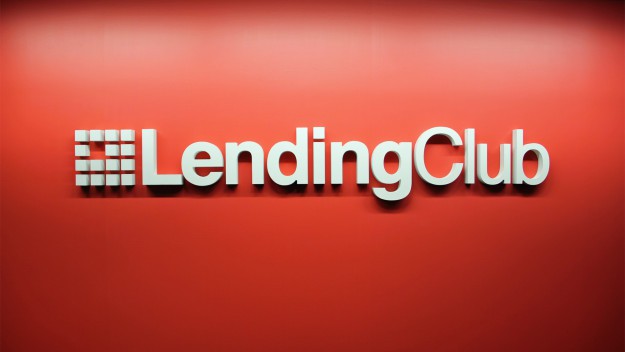
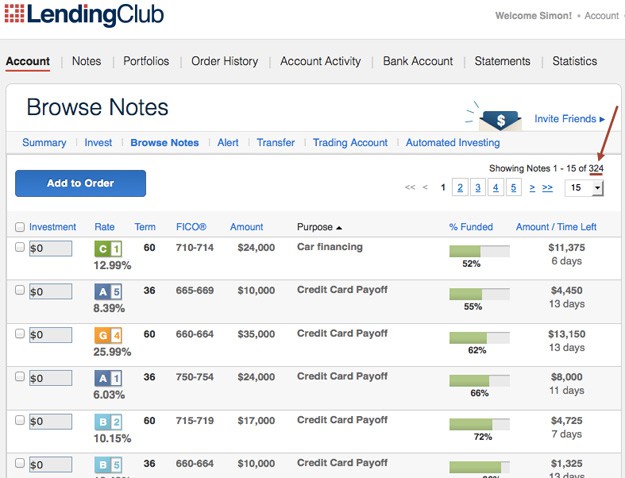
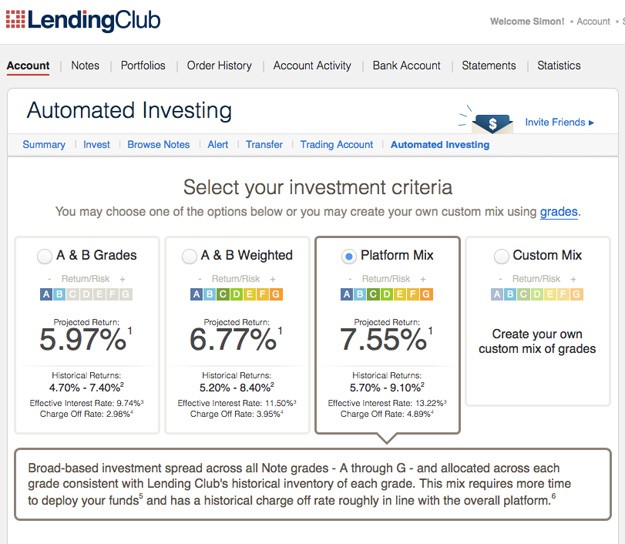
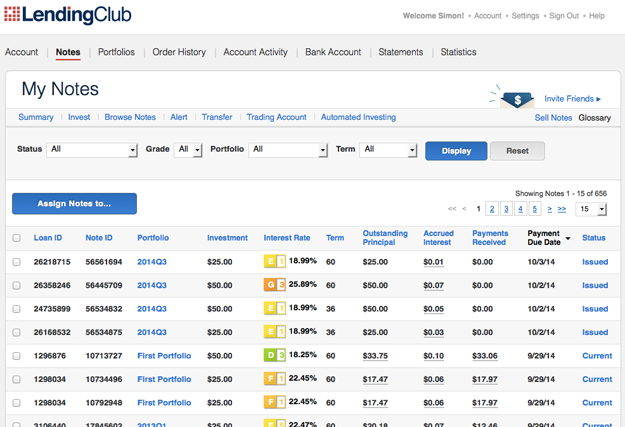
Last month, I started investing a small amount in Lending Club so that I can learn the business. The main concern I have is the amount of time it will take to liquidate the money in there if there is any urgent need. Unless you trade your notes in the secondary market, it will take anywhere between 1 month and 5 years to fully liquidate your account. Is my understanding correct? Also, I have seen an article in which even on secondary market, it took active trading for 3 weeks before all of that author’s notes were sold.
Hi Jaison. You can actually liquidate your notes much quicker than a month. See here: https://www.lendingmemo.com/liquidate-close-lending-club-prosper/
What would happen if Lending Club went bankrupt? What could happen with the money you have invested on your IRA?
See risk #4. The loans would likely still be paid back, but there are some caveats.
excellent informative article useful information learned thanks
This is an old article, so I hope I can still get a response and insight from you regarding my question.
I am investing through the Lending Club currently, however due to a few unforeseen circumstances a situation is likely to arise that I might end up defaulting on business credit cards for my LLC which has delivered significant YoY losses. All personal and business free cash is invested either through LC or in the company itself.
Hypothetically speaking and preparing for the worst case scenario, if a few payments on the business card are missed, and heaven forbid it goes into collections or worse, does it affect my personal standing or curb activities with Lending Club such as existing or any new loans I give out?
They are rich..either they can invest in their own work or they can hand out charitable “investments” not designed to parasitize actual productive people.
What is the minimum investment?
You can invest with as little as $2,000 if you follow the article in the sidebar.
I notice that Lending Club seems to be a great platform for investing. Are their any other criteria we need to know about the website, state regulations or mininum income requirements? In my research it says you have to make 70k. I do reside in one of the states that allows for investing in notes. Am I not reading this article correctly? Please advise.
https://help.lendingclub.com/hc/en-us/articles/216092957
Thanks.
Thanks for sharing this great article.
It was really informative.